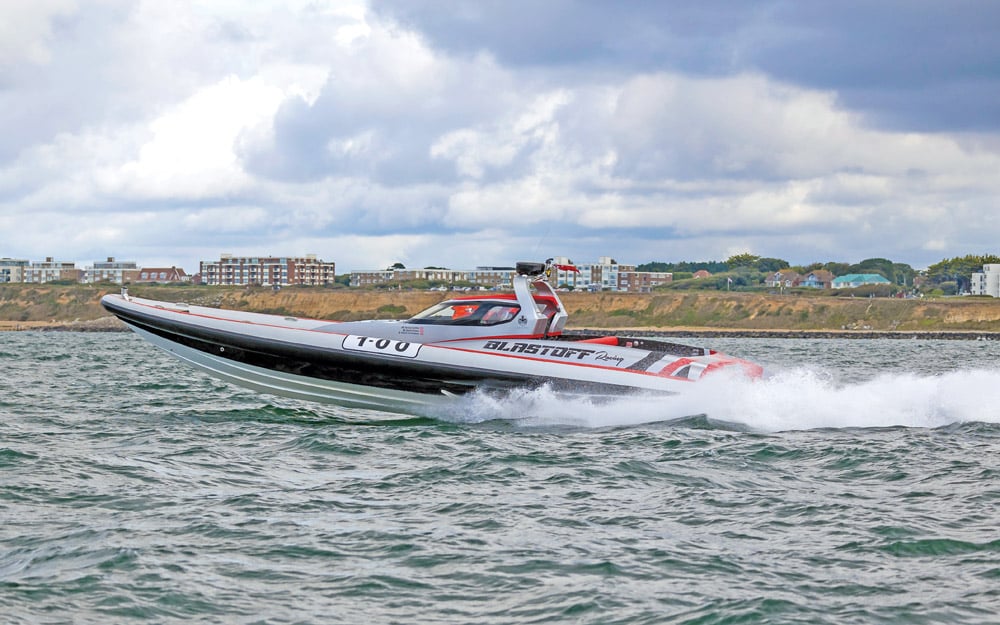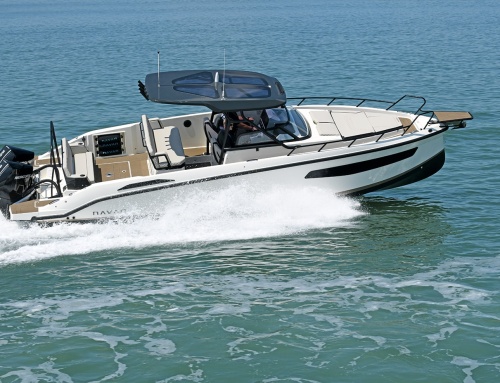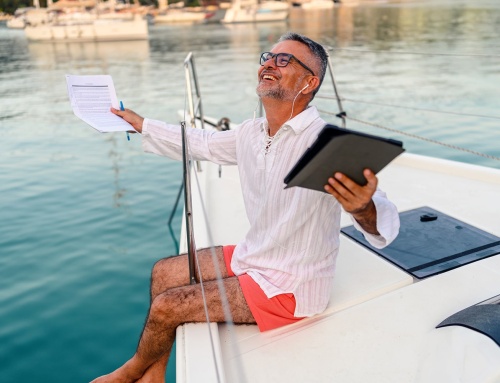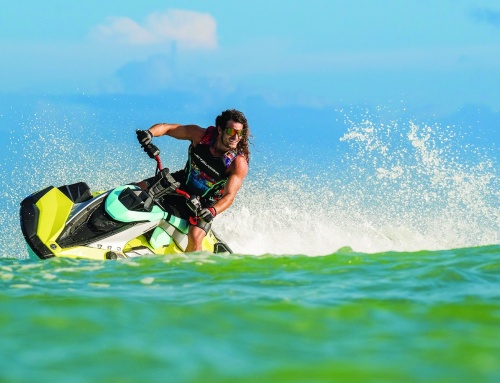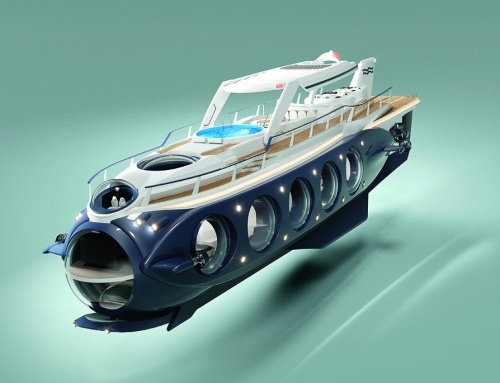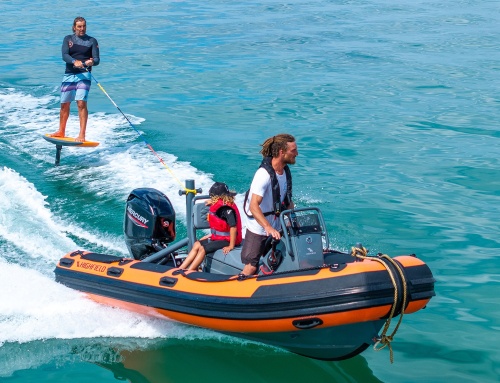Championship racer Dorian Griffith provides an engaging, not to say lively, first-hand account of this year’s Cowes–Torquay–Cowes offshore powerboat race. Brace yourself for a rough ride aboard his 42ft Cougar thoroughbred, Blastoff!
The British Powerboat Racing Club’s Cowes–Torquay–Cowes 2023 event was certainly one our Blastoff team will not forget in a hurry! The 62nd running of the longest, hardest, most prestigious powerboat race in the world was an event where literally anything could happen, and where, true to form – and not for the first time – it most certainly did!

Left to right: The team: Dave Frewin (helm), Dorian Griffith (throttles) and David De Kretser (navigation).
We were up against some serious firepower – in particular, no less than 12 Offshore Class 1 Monohull race boats, the biggest fleet in the world, some running well in excess of 2000hp and measuring up to 52ft long! These are incredible machines, constituting extraordinary competition with potential speeds of over 130mph.
We knew we were outgunned from the start, as our trusty steed Blastoff, being propelled by a ‘meagre’ 1450hp in comparison, tops out at a little over 100mph in favourable conditions. This being the case, we knew we had to think tactically and keep in mind the old saying ‘To finish first, first you must finish!’
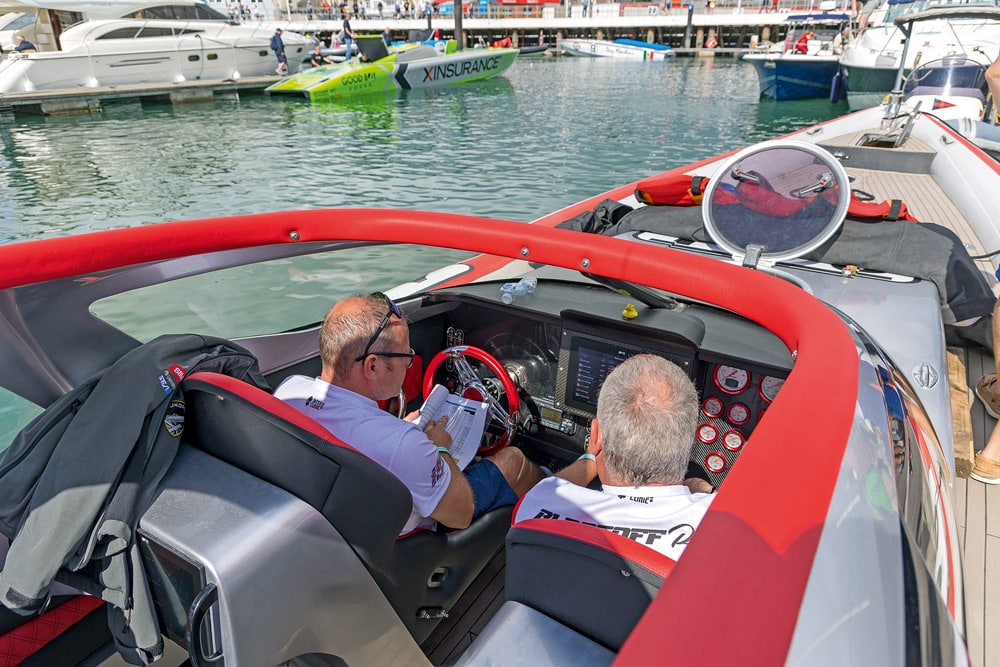
Chart plotting and race preparatiion.
Start line mayhem
Our aim was to get a solid start and then pace ourselves, as there appeared little point in out-and-out racing the multi-thousand, turbo-horsepowered Outerlimits, or the Mercury Racing V8-engined Silverline and Goodboy Vodka projectiles for that matter. Instead, we determined that our aim should be to spearhead the chasing of the pack and consolidate a decent position as close as we could behind the leaders in order to nibble at their heels should they begin to lag or suffer a problem.

That said, the official race start was hopeless. A new procedure required boats to line up alongside each other according to a predetermined order. To be frank, it was all over the place, and by the time the start boat came running up alongside us, it seemed that every boat was seeking to reshuffle its position in anticipation of gaining an advantage. As the race is over 200 miles long, we decided to hang back and let the mayhem unfold clear in front of us, but once the chequered flag had been lowered, the fleet was quickly up on its feet and charging forth. For our part, we powered straight up the centre of the Solent, and by the time we reached the first turn at Hurst Castle we were holding third place. By now, though, the two much faster Outerlimits boats were rapidly disappearing into the distance.
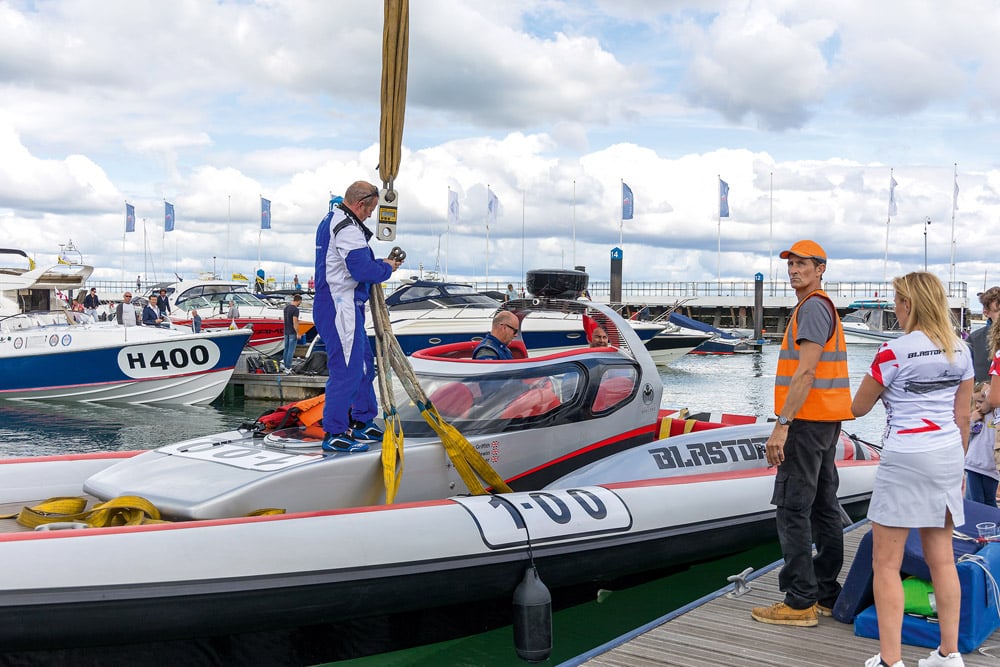
All important post race weighing.
Into the rough
The sea conditions across the bay to Bournemouth were favourable and allowed us to push the throttles down hard, with the result that we were increasing our distance from the rest of the pack. By the time we got to Durlston, the sea state had significantly deteriorated due to a big swell coupled to a fair degree of white water. At this point we backed off the power, thinking that if it was bad here, around and beyond Portland could be very testing indeed. The downside of this decision, though, was that the fastest of the chasing pack, Bubbledeck, a 39ft Cigarette with two V8 petrol aspirated Chevrolet engines, could be seen vying alongside us.
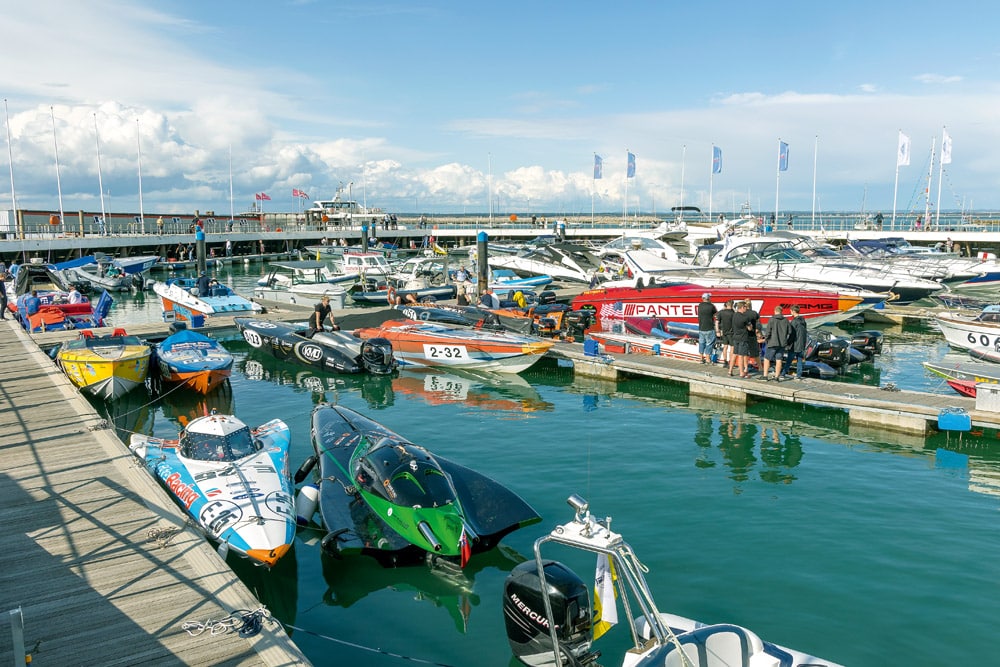
The sea conditions were getting worse with every mile gained, so I elected to slow a little more again to preserve the boat. We could see Bubbledeck leaping clear of the sea, placing her and her occupants under much stress in the process. A few minutes later – you guessed it – we saw our opponent lying stationary in the water. It transpired that Bubbledeck’s dipstick had been shaken out amid the impacts being suffered, with the result that oil pressure was being lost rapidly as oil spewed out over her engine manifold. We came off the plane to check that the crew were not in distress, and with the official race helicopter hovering overhead, we were given the thumbs up that all was under control.
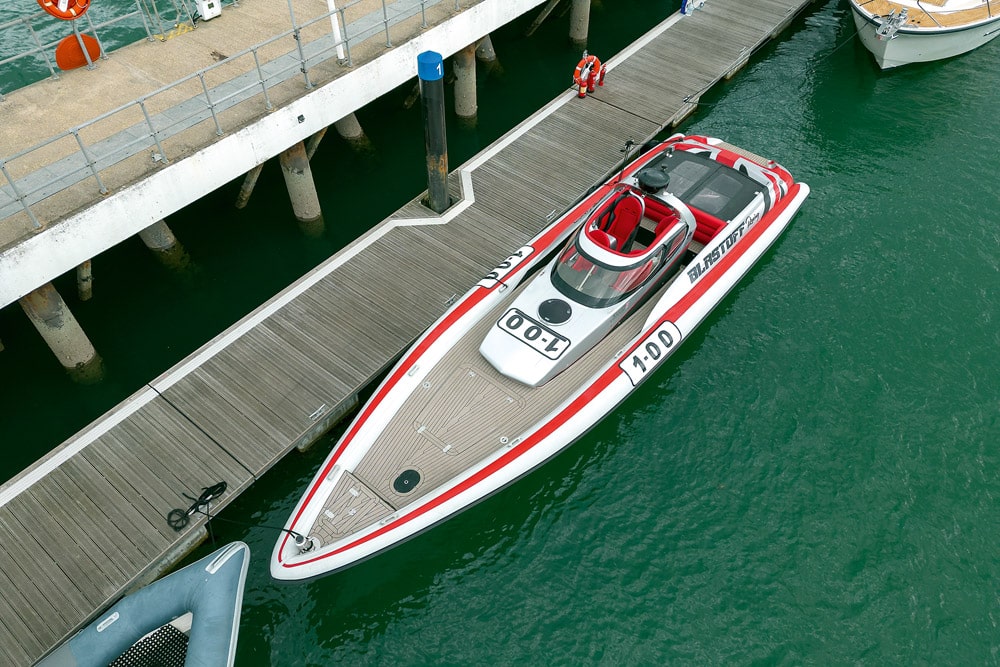
We continued at our slower pace past Portland Bill, where we met a substantial head sea – the sort of conditions that most, if not all, race boats hate. I had been in similar circumstances during the 2016 race where we came second overall, and on that occasion, as now, we looked at running much closer to the shore of Lyme Bay in order to gain some lee out of the westerly blow. Frustratingly, as we headed northwards toward the Dorset coastline, we found no significant improvement, so we decided to resume our previous westerly course toward the distant coast of Devon. In the process, we adjusted the trim to pull Blastoff’s nose right down in an effort to minimise the impact of the head sea and preserve the boat’s constitution. But alas, at 35–40 knots, it felt as if we were now clawing our way across the bay – a wide and lonely expanse of water fringed, though out of view, by the great rampart of Chesil Beach.
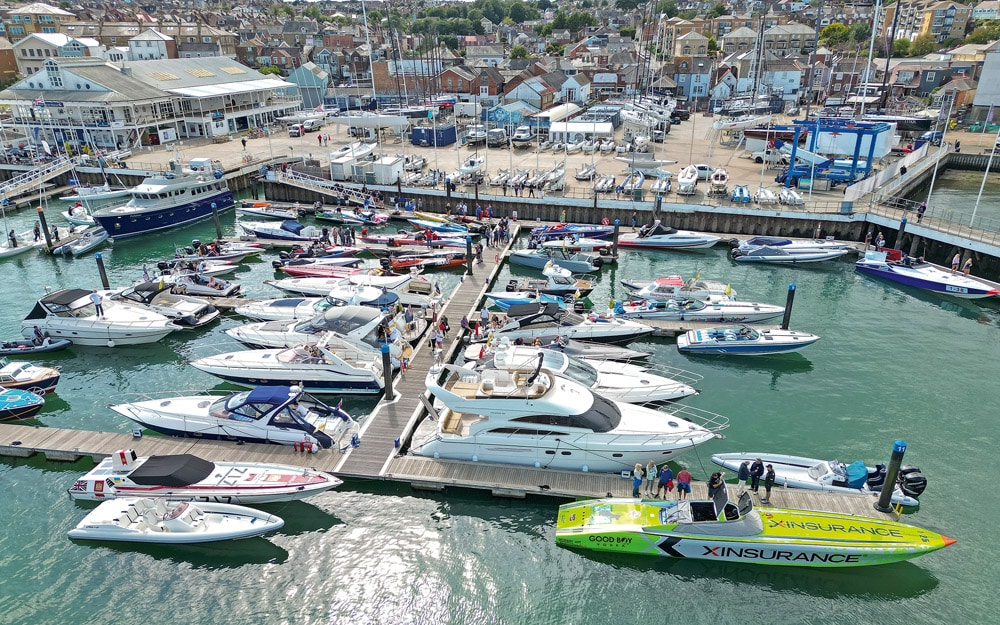
The Torbay turn
On we pushed past Charmouth and Lyme Regis, the white cliffs of Beer Head, the definitive red sandstone shoreline of Budleigh and Exmouth, and then, to our joy, the welcome profile of Berry Head on the far side of Torbay. The latter, heralded by the profile of Thatcher Rock, was now directly on our bow. Ahead, just off to starboard through the shifting surface of the seas, we then saw two rooster tails coming toward us. They were shi fting at a goodly speed too, and upon hoving into full view, it was clear that these were the two ‘Chevy’-powered Outerlimits boats, no doubt fighting out their own private battle on a direct return course set for Portland Bill, some 30 miles east of our position.
As we closed Torbay, the wave height reduced, which allowed us to increase the speed once more. Upon rounding the marks within Torbay, we rounded up to head back out across Lyme Bay, but this time with the sea now chasing our stern. We were all but alone once more, with the following seas, which were clearly building astern, being our only company.
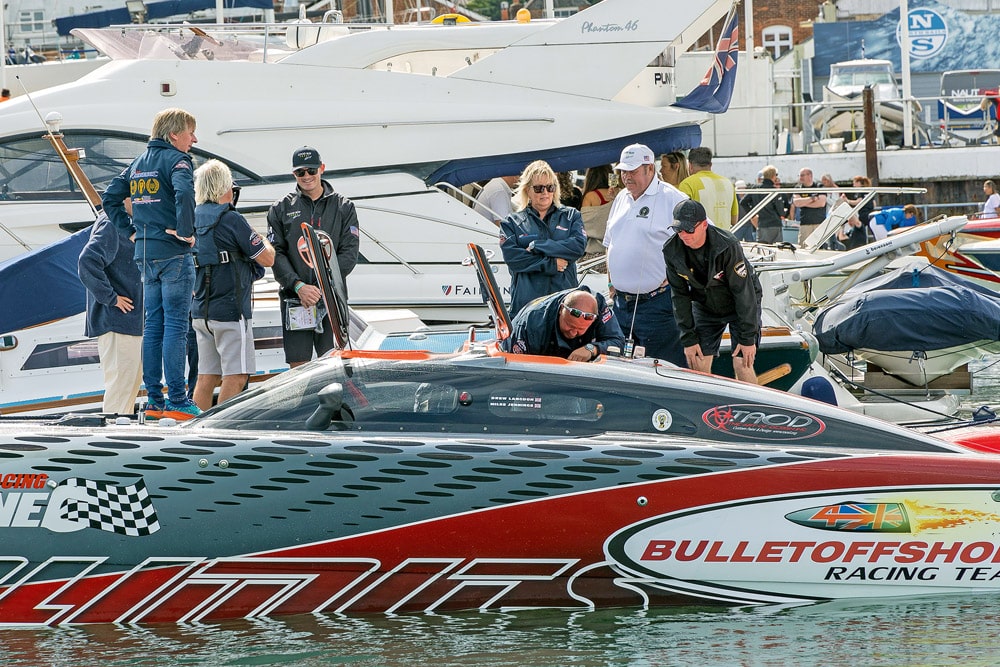
Final race preparations in Cowes Marina.
Our flight across the bay was lively. Travelling at 65 to 70 knots, the troughs beneath Blastoff’s hull were like valleys being leapt. But then, as Portland Bill emerged through the gloom, we spotted a rooster tail and a flash of green. It had to be Good Boy Vodka.
Going green
With the excitement of actually catching this magnificent craft, I couldn’t resist the urge to accelerate our pace even further. Oh, but what a mistake! A trough, greater than Blastoff’s 42ft hull length, opened up before us and into it we went, headlong! Everything went dark as the green water flooded over the vessel’s topsides, but instinctively I pushed the throttles forward in an effort to restore momentum, and to her credit, we popped out the other side apparently unscathed.
Blastoff’s designers, Steve Curtis and Trevor Leigh, had evidently thought through such a scenario when they’d incorporated into the boat’s cockpit a resoundingly efficient drainage system, which, via a large bore tube apparatus, came to our aid without a moment’s delay, sucking the shipped water from the cockpit and on out through the transom to whence it came. With the additional help of the bilge, in no time at all the cockpit was clear and we were rid of our unwanted payload, regaining our lost speed in the process. But despite the mishap, we were closer to Good Boy Vodka than ever before. However, being a much longer boat than ours, her reach over the troughs meant she could bridge them far more easily. Even so, sneaking in behind her to run in her wake meant we could keep hard on her tail.
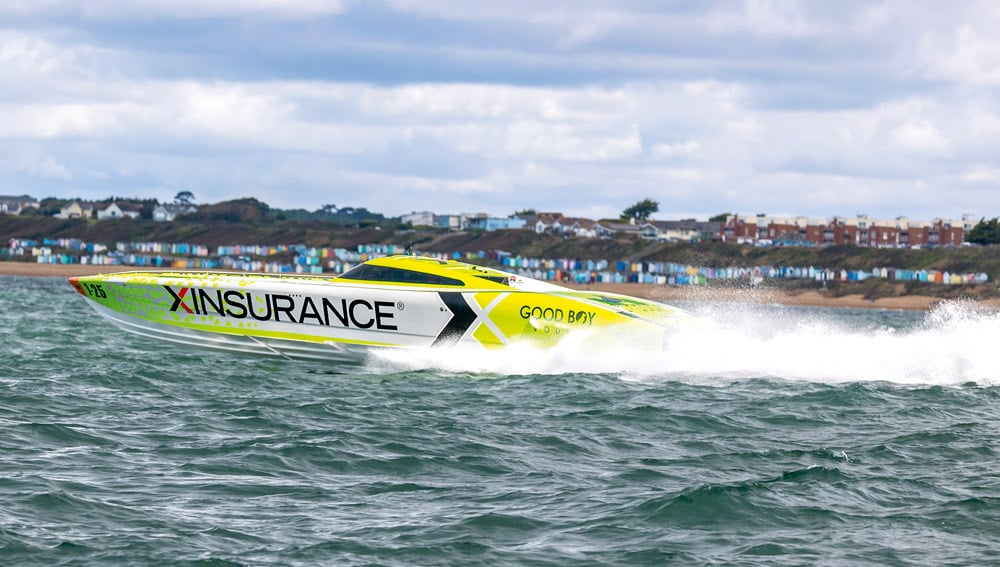
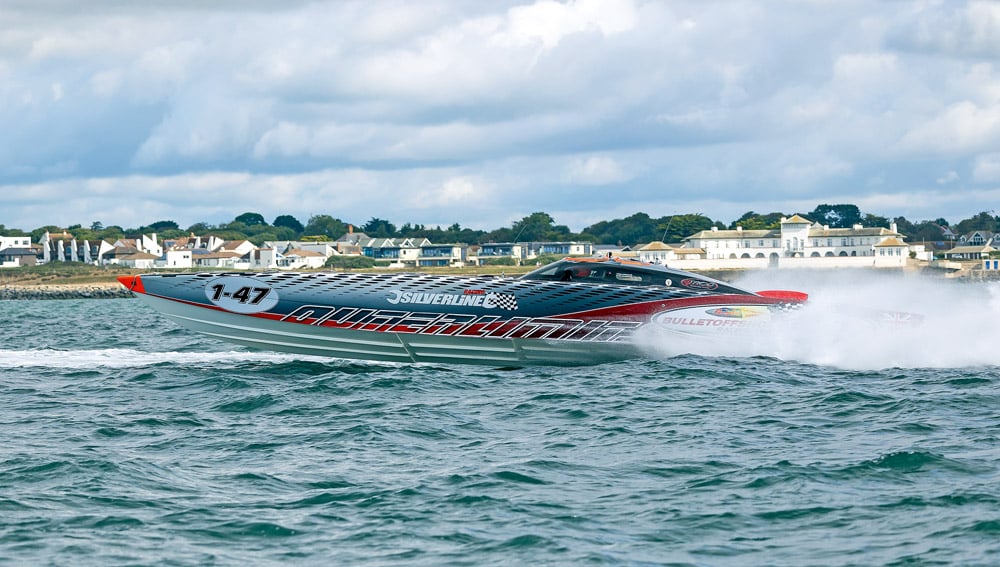
Burning oil
The smell of burning oil was noticeable in Good Boy Vodka’s slipstream. Something was wrong and their misfortune was allowing us to gain a growing advantage. As soon as we passed Durlston again, it was a straight line on to the North Head mark. By the time we’d rounded the latter we’d managed to beat our way past Good Boy Vodka and could see her labouring in the rough, increasingly trailing behind. Their mechanical issues were undoubtedly to blame, but such is the nature of this great endurance race. Cowes–Torquay–Cowes can so often amount to a war of attrition, of gear failures and breakdowns; and like the Grand National, it’s a tough, arduous course that by no means guarantees that the laurel wreath is granted to either the biggest or the fastest in the fleet.
With positivity abounding, we revelled in the wonderful sound of Blastoff’s Ilmor V10s singing their melodious tune as we sped through the Hurst Straits and into the welcoming waters of the Solent. Our Cougar-designed race craft had fought the fine fight and done us proud. Who could deny that finishing in second place overall was, in light of this year’s field, pretty incredible? What an outstanding race it had been, and what a privilege to race against such illustrious craft as those that had amassed on the start line of this year’s 2023 event.
For our part, we hope to see you next year at the 63rd Cowes–Torquay–Cowes!
Special thanks
I feel compelled to give special thanks to Trevor Leigh, who in my experience is the finest mechanic there is. Thanks also to his wonderful wife, Shelley Jory-Leigh, for organising us all and ensuring our team complied with all the necessary rules and regs pertaining to this complex and demanding event. My gratitude too goes to Dave Flewin, Blastoff’s helmsman – the poor individual who has to suffer my throttle work! And not forgetting either our new teammate David De Kretser, who contributed so massively to our team’s success.
Besides my family and friends, I also want to thank all the organisers at the British Powerboat Racing Club who ran the race, UKOPRA, the sanctioning body, and all the officials and safety crews and boats who dedicate their time and resources to keep this wonderful race going, without whom the likes of Cowes–Torquay–Cowes could never be staged. Finally, if it wasn’t for my late father and more recently my late mother, I wouldn’t have been blessed with the powerboat racing bug in the first place. I am forever grateful to them for passing this legacy on to me, as well as their love and passion for the sport. I miss them both.
‘Blastoff’ – an evolving boat
- Since acquiring this Cougar-designed thoroughbred race boat, the following upgrades have been undertaken:
- I’ve sourced and built two Ilmor MV-10 725hp engines.
- I’ve changed to Hering high-performance propellors.
- I’ve stripped out the cockpit and its soggy upholstery and replaced them with lightweight Silvertex – the latter for the Qatar F1 seats installed at the time of the original build.
- I’ve replaced all old navigation equipment with Raymarine Axiom series chartplotters.
- I’ve commissioned a bow tank for rough-running weight stabilisation.
- We have also undertaken a partial respray and wrap, which will be updated over the coming winter months.
- Extra sun cushions have been made to cover the engine hatches, and a bench seat has been created for use behind the cockpit to seat an extra four or five people.
- Silencers on the exhausts have also been acquired for marina use. These items are all part of Blastoff’s optional leisure guise!
- Permanent fixed-viewing fore and aft cameras have been added since losing our GoPro 360 when we took the wave of Portland Bill.
- The boat’s power-to-weight ratio is now 3.75kg/hp, and she’ll make a good 100mph plus.
For further information visit https://www.blastoffracing.com and click on ‘The Boat’.

